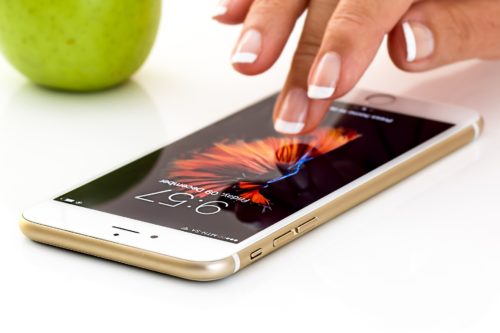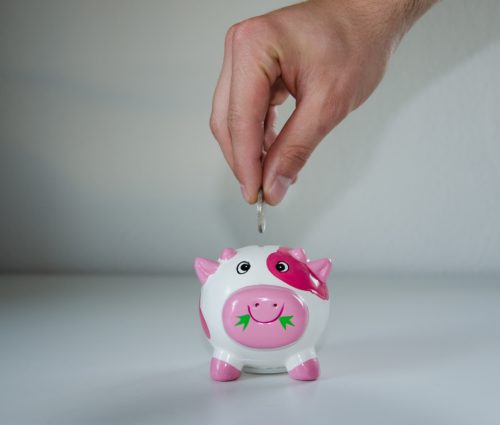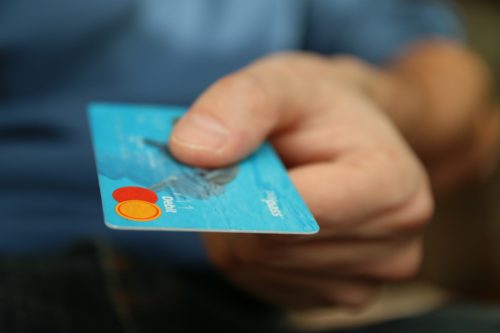When you're in debt, a looming cloud shadows your every moment. Every new purchase makes you cringe, but what can you do? Stop buying stuff? Obviously not, but there is another option. Qoins is an app that allows you to pay down your debt with every single purchase.
It doesn't matter if you've got a crushing student loan, an underwater mortgage, or a credit card that keeps you up at night. Read on for The Budget Diet's Qoins Review. We'll tell you if this app will help you save money or if it's not worthwhile.
What is Qoins?
Qoins is a startup. When you sign up, you allow the Qoins app to connect to your bank account. When you make a purchase using your debit card, Qoins rounds that cost up to the nearest dollar. The difference between your charge and the next highest round dollar amount goes toward paying off your debt. That means that for a purchase of $1.35, Qoins would take $0.65 out of your account. If you spent $9.77, it would take $0.23.
This money stays in an account you can't access. Qoins then uses that account to send extra payments to a lender of your choice. Your spare change helps you to get out of debt faster.
It's even possible to set Qoins to round up to the next $2 or $3 if you want to pay your debt more aggressively. The investment app Acorns operates on a similar principle, except that it invests your money instead of using it to pay off your debt. If you already have an Acorns account, then you know how much of your personal capital can be expressed in pennies and nickels. The investing idea has been so popular that it's no wonder other apps are mimicking the idea.

Qoins has been active since 2017. It was invented by a 25-year-old from Atlanta, Georgia named Chris Zimmerman. He conceived of the idea after while working toward debt freedom. However, since then, it's reportedly seen increasing popularity and paid off over $30,000 in debt. While it began as a way to pay down student debt and credit cards, it now works with almost any type of loan, from car loans to mortgages. As long as your loan provider has an address where they can receive checks, Qoins can help you pay them off.
Using Qoins
How Qoins Works
Since you link Qoins to your account electronically, it debits each rounded amount right away. You don't have to worry about that money once it's gone. Qoins hangs onto it. You can choose how Qoins uses that money to pay off your debt.
There are two ways to use Qoins right now. Lump sum mode is a plan that sets Qoins to mail your accumulated pennies out to your lender once a month. This costs $1.99 per month, flat rate, no matter how much you save. Threshold mode mails your payment whenever Qoins has saved a certain amount of your money. For example, once it makes $10 from your spare change, it mails a check out immediately. Pricing is a little more complicated for threshold mode. We'll get into that a little later in this piece.
There key thing to understand is that Qoins mails a paper check to your lender. That means that every Qoins payment isn't applied to your account for 7-10 business days.
Tech Skill Level Required
The Qoins service lives on the Internet. Its app installs on both IOS and Android. Download the app and check it out for yourself. The easy-to-use interface is hard not to like. There's even a nicely designed tracker that shows you how much you've paid and how far you've got to go on your debt. Best of all, the app only takes 5 minutes to set up, as long as you've got all of your account information on hand. DoughRoller has some gorgeous pictures of Qoins in use, so head over and check that out.

There are some management actions that you need to be aware of that make the app most suited to a tech-savvy crowd. For one thing, you need to understand Qoins' app interface well enough to put your payments on hold if necessary. As we'll discuss a little later, Qoins will bill you if you've got insufficient funds in your source account.
Qoins Costs
Qoins makes its money by charging fees. If you use lump sum mode, you pay $1.99, as we discussed above. Qoins pays your lender once a month as long as it's gleaned more than $5 from your purchases. The total cost of lump sum mode is $24 per year. Keep in mind that you'll pay that $1.99 whether you've accumulated $5 or $25. It's a flat rate. For people whose interest compounds monthly, this is probably the best option.

Threshold mode pays out whenever Qoins has saved a certain amount of money. For example, if you want, Qoins will send money to your lender every time it saves at least $10. If your interest compounds fast, then this can seem like a good option. The problem is that Qoins charges $0.75 per transaction plus $.05 per dollar for threshold payments. This adds up fast. If your threshold is $15, you'll pay $1.50 just for that transaction. Qoins might glean $45 per month from your transactions, which would add up to $4.50 in fees if you're using threshold mode. That's more than twice what you'd pay otherwise!
The Interest Cost/Benefit Analysis
For a high-interest-rate loan that compounds daily, the threshold model might make sense. This would depend on how much you can save on interest. If you have a $50,000 student loan that compounds daily at 6.5%, for example, then you might consider it worth your while to get ahead of the interest, especially if you choose to let Qoins round to a higher amount.
However, it's worthwhile to sit down and calculate your exact interest savings with Qoins before you start using it. WiseBread points out that paying an extra $500 per year on your student loans may only save you $25 in interest. Qoins will cost you $24 per year, so in terms of interest savings, you haven't taken good advantage of the system. You might consider simply raising your payments on your own, or possibly rounding to a higher dollar amount if you want to try Qoins anyway.

Finally, Qoins will charge you a fee if you have insufficient funds in your account for withdrawal. This could cause your Qoins experience to spin out of control, much in the way that a bank overdraft can become a downward spiral of fees for fees. Don't get into more debt while trying to manage the debt you've already got! Only use Qoins if you're confident about the state of your bank account.
Lag Time
We mentioned earlier that Qoins cuts checks to pay your loans. It uses a system similar to ETF to take your spare change out of your bank account, but when it pays off your lender, it uses the most tried and true of low-tech methods. Although this may sound a little backward for a tech startup, it's actually good because it means there's almost no debt that Qoins can't pay. As long as your lender has an address, Qoins can find them and pay them. However, it also means that this service relies on the postal service. That's why there's a lag of 7-10 business days between a Qoins payout and the application of that money to your debt.
We don't consider this a very serious issue. Ultimately, the money does get applied to your account. You'll still be making your payments as usual, so you won't be late or get fees. What Qoins pays is just icing on the cake.

Addressing Your Debt With Qoins
If you don't have long-term debt, then Qoins won't be useful to you. For instance, this service is not a good way to pay off a credit card if you're already paying the card's balance every month.
However, if you're carrying a balance, then Qoins might be a good way to chip away at it. Qoins won't solve your debt problems – after all, it's collecting your pennies – but every little bit counts when you're trying to get out from under a lender's thumb. That's particularly true when the debt you're trying to manage comes with a high interest rate.
Qoins doesn't accumulate much, but any extra payment goes further if your interest rate is unfavorable to you. Qoins payments that are high enough to pay your interest fully and affect your principal will do you the best. Otherwise, Qoins can still take out some of that annoying buildup from your interest and give your actual monthly payment a better chance at taking down your principal.
👉 10 Proven Ways To Pay Off Credit Card Debt.

How Effective Is It?
Users of Qoins report that the app pays down an average of $40 in debt a month– not factoring in the $1.99 monthly fee– when users set it to round to the nearest dollar. That's $480 a year! For smaller debts, this can make a big difference. Even for larger ones, it can help. Remember, you can always set Qoins to round higher. If you round to the nearest $3 increment above your expenditure, you could more than triple that amount. Theoretically, you could contribute and save thousands of dollars.
Using Qoins means paying for things with your electronic banking card rather than a credit card. If using a credit card has been problematic for you in the past, then using Qoins as a behavior modification strategy alone might be effective for you. If you use your bank card every day and make it a habit to check your account online regularly, you can keep a closer eye on where you stand financially.
The Mass Debt Problem
Qoins is becoming popular because nearly everybody has debt these days. American student loan debts by themselves add up to over $1.5 trillion as of 2019. These loans can be high-interest, and it is 100% possible for a student loan debt to go underwater. Altogether, this is a nightmare scenario for the one group of people who should be most ready and willing to invest in new businesses, houses, and retirement accounts.

Most people are also managing their debt well. They just live with it. It's a fact of their lives. But why should you tolerate that? A tool like Qoins can certainly help. In combination with debt consolidation and other smart money moves, it can chip away at the mountain of debt that looms not only over you but over almost everyone you know.
Who Should Use Qoins?
If you make a lot of electronic payments with your debit card, then this is the app for you. Qoins depends on your habit of using a bank card for your transactions to work. The more money you spend with your bank card, the better the deal you'll get on the service.

You should also be making your minimum payments on your debt, at least. Qoins is not a substitute for standard debt repayment strategies. Instead, think of it as a supplement. It can add on to what you're already doing and give your payments some more punch.
Make Sure Your Bank Account Is Stable
Finally, if you're living hand to mouth, Qoins is probably a bad idea for you. You'd be surprised how fast those pennies can add up, and the last thing you want is for Qoins to empty your checking account of the last $25 that you're counting on to make your monthly living expenses. Plus, even one fee for insufficient funds can throw off your budget. Overdraft fees on your checking account could easily compound this situation.
If times are tight, keep making your minimum payments and throw as much extra money as you can afford at your debt. Consider getting debt counseling if your situation is particularly dire.

The Final Word
There's a lot to be said for Qoins. It's an innovative and interesting app. The concept is great, the service is thoroughly legitimate and upstanding, and it's got a ton of fans already. The real question is whether it's necessary. Even though $24 a year isn't much of a fee, it's also not zero. If your budget is tight, you might well wonder if this service is worth your while.
Qoins Is Effective, But Do You Really Need It?
Any amount of money that you save on interest with Qoins needs to be adjusted for the subscription fee that it charges. If you can afford to dump $40 per month in pennies at your loan, you can afford to raise your payments $40 a month too. We've already seen how fast pennies can add up. Why throw them at Qoins when you can just make a second payment toward your debt every month? This goes double for threshold payments. Instead of paying per dollar and per transaction, you could be your own Qoins and send checks to your creditor every week without incurring a fee.
That said, you can set Qoins to round to amounts of money higher than $1. If you're rounding to $2 or $3, then you still pay just $1.99 per month if you're using lump sum mode. At a $3 round, you might be throwing as much as $120 a month at your lender. You'll save more in interest and potentially make real headway on your debt.

The Fee Is Manageable
Finally, $24 a year isn't a terrible price. If you're an average American, then you likely spend more than that each month just eating out. Qoins might appeal to you for lots of reasons, including lifestyle. Meanwhile, if you want to consider this option, think about cutting back one meal out a month. Even if all you get every month is a single $2 coffee, that change ought to cover the cost of using Qoins.
Despite its weaknesses, thousands of people already use and love Qoins. The app has a lot of appeal. Ultimately, it does apply at least $480 to your debt every year. It's a set-it-and-forget-it system that people like. Their debt seems to shrink magically. Combined with student loan refinancing and other management strategies, it can be a powerful tool.
The Future Of Qoins
As it develops, Qoins continues to add new features to its mobile app and online service. For one thing, it's working on a system where multiple people could use Qoins to pay off one account. This could be a game-changer, allowing an entire family to pool their resources to help get one member out of debt. For example, parents could start paying their child's loans while they're still in school.

Qoins Alternatives
Regardless of how cool Qoins is, you might also want to consider the alternatives. Autopay is a great way to make sure that your loan disappears on or ahead of schedule. All major credit cards and student loan services feature this service, so consider logging into your online account and seeing if you can adjust how much your creditor takes every month. Autopay is usually available on your loan servicer's web page.
If this doesn't work for you, look into sending your lender an extra check every month through your bank's online automatic bill pay system. Odds are good that it has one, and if it doesn't, you can switch to a bank that does. You should be able to set up automatic monthly or weekly check payments to anyone you'd like as long as you have their address. Not only is this a great way to throw extra money at debt, but it's also a smart solution to rent payments, utilities, and other regular expenses.
Pay Down That Debt!
There are a lot of ways to pay off credit card debt. The Budget Diet can even get you started! If you've got more than $10,000 on credit cards, read up on how to pay off $20,000 in credit card debt. Alternatively, use a Qoins alternative. Programs like Undebt.it and Debt Tracker Pro can re-empower you. Check out our list of top debt payoff apps to retake control of your financial life and your credit score.



